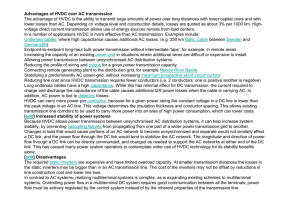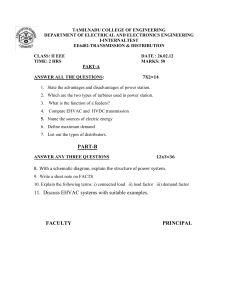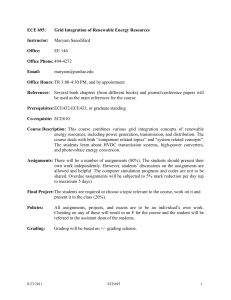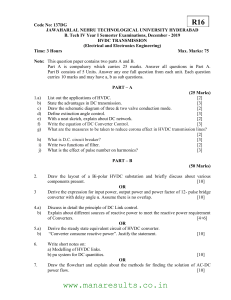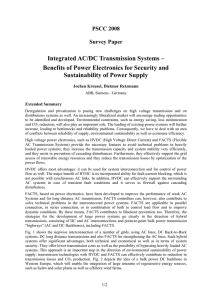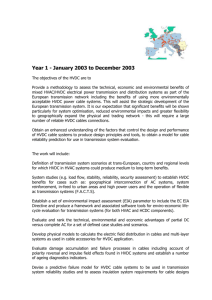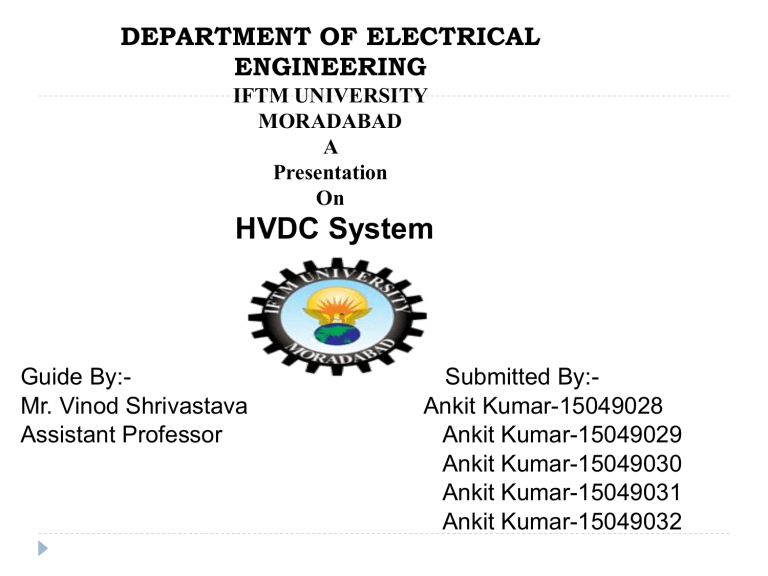
DEPARTMENT OF ELECTRICAL ENGINEERING IFTM UNIVERSITY MORADABAD A Presentation On HVDC System Guide By:Mr. Vinod Shrivastava Assistant Professor Submitted By:Ankit Kumar-15049028 Ankit Kumar-15049029 Ankit Kumar-15049030 Ankit Kumar-15049031 Ankit Kumar-15049032 HVDC stands for High Voltage Direct Current and is today a well-proven technology employed for power transmission all over the world. HVDC technology is used to transmit electricity over long distances by overhead transmission lines or submarine cables. It is also used to interconnect separate power systems, where traditional alternating current (AC) connections can not be used. Non-synchronous Long undersea cable Long-distance HVDC links can be broadly classified into: Monopolar links Bipolar links Homopolar links It uses one conductor . The return path is provided by ground or water. Use of this system is mainly due to cost considerations. A metallic return may be used where earth resistivity is too high. This configuration type is the first step towards a bipolar link. If one pole is isolated due to fault, the other pole can operate with ground and carry half the rated load (or more using overload capabilities of its converter line). Each terminal has two converters of equal rated voltage, connected in series on the DC side. The junctions between the converters is grounded. It has two or more conductors all having the same polarity, usually negative. Since the corona effect in DC transmission lines is less for negative polarity, homopolar link is usually operated with negative polarity. The return path for such a system is through ground. 1. 2. 3. 4. 5. 6. 7. Converters Smoothing reactors Harmonic filters Reactive power supplies Electrodes DC lines AC circuit breakers Components of HVDC [2] Objectives of Control ◦ ◦ ◦ ◦ Efficient and stable operation. Maximum flexibility of power control without compromising the safety of equipment. Principle of operation of various control systems. Implementation and their performance during normal and abnormal system conditions. Direct current from the rectifier to the inverter Id V dor cos R cr V doi cos Rl R ci Power at the rectifier terminal Pdr V dr I d Power at the inverter terminal Pdi V di Id Pdr RLId 2 Schematic diagram of control [2] Internal voltages V dor cos and V doi cos can used be controlled to control the voltages at any point on the line and the current flow (power). This can be accomplished by: ◦ Controlling firing angles of the rectifier and inverter (for fast action). ◦ Changing taps on the transformers on the AC side (slow response). Power reversal is obtained by reversal of polarity of direct voltages at both ends. Power control To transmit a scheduled power, the corresponding current order is determined by: Po / V d I ord Bridge/converter unit control Determines firing angles and sets their limits. Pole control It coordinates the conversion of current order to a firing angle order, tap changer control and other protection sequences. BLOCK DIAGRAM OF CONTROL IMPLEMENTATION[2] HVDC links can stabilize AC system frequencies and voltages and help with unplanned outages. Renewable electricity superhighways in Smaller use. A 500 V,1500 W,810Km bipolar HVDC transmission line is set up between Rihand & Delhi. In Vindhyachal back to back link is laid for exchange of power between Northern & Western regions. scale •For equivalent transmission capacity, a DC line has lower construction costs than an AC line. •A double HVAC three-phase circuit with 6 conductors is needed to get the reliability of a two-pole DC link. •DC requires less insulation. •For the same conductor, DC losses are less, so other costs, and generally final losses too, can be reduced. •An optimized DC link has smaller towers than an optimized AC link of equal capacity. Price vs distance [2] Reactive power requirement System stability Short Circuit Current Independent Control of ac system Fast change of energy flow Lesser Corona Loss and Radio interference Greater Reliability. • • • DC lines and cables are cheaper than ac lines or cables. The towers of the dc lines are narrower, simpler and cheaper compared to the towers of the ac lines. Line losses in a dc line are lower than the losses in an ac lines. Cost vs distance [1] Distance vs losses [1] The disadvantages of HVDC are in conversion, switching and control. Expensive inverters with limited overload capacity. Higher losses in static inverters at smaller transmission distances. The cost of the inverters may not be offset by reductions in line construction cost and lower line loss. High voltage DC circuit breakers are difficult to build because some mechanism must be included in the circuit breaker to force current to zero, otherwise arcing and contact wear would be too great to allow reliable switching. application of HVDC. Very large investments in e.g in China and India shows that high-voltage direct current will very important in the future, especially in big, new-industries countries. Recent studies indicate that HVDC systems are very reliable. The data collected from 31 utilities says that forced unavailability of energy due to the converter station is 1.62%. The scheduled unavailability of energy is about 5.39%. [1] Lips H P. “Aspects of multiple in feed of HVDC inverter station into a common AC system”, IEEE Trans. on Power Apparatus Sys. vol .2,pp 135-141, 1973 [2] Xiao Wang, Boon-Tech Ooi. "High Voltage Direct Current Transmission System Based on Voltage Source Converters", IEEE Trans.on HVDC Sys. vol.1,pp. 325-332,1990 [3] R. N. Nayak, R. P. Sasmal, Y. K. Sehgal, et al, "AC/DC interactions in multi-infeed HVDC scheme: a case study," IEEE Power India Conference, pp. 5-9, 2006 Thank you!
